The principle of operation of a gas column: features of the device and operation of a gas water heater
If your house does not have hot water or hot water is constantly turned off for you, then life becomes completely uncomfortable. But this is not a reason to abandon a warm shower on a cool autumn evening, agree? This problem can be solved by installing a gas column, as many users do. But how does such a miniature water heater work and can it cope with its task?
We will talk about all this in detail in our publication - here we consider the principle of operation of a gas column, the scheme of its structure. And also focuses on the main equipment malfunctions and ways to cope with them. The material presented is supplemented by visual illustrations, diagrams and videos.
The content of the article:
The general structure of the household speaker
The gas water heater is instantaneous water heater. This means that water passes through it and heats up along the way. But, before proceeding to an analysis of how a domestic gas column for heating water is arranged, we recall that its installation and replacement are associated with a centralized gas supply system.
Therefore, it is necessary to submit documents to the gas service of your region together with the corresponding application. ABOUT norms and necessary documents You can read in our other articles, and now let's move on to the device.
Different models of gas columns differ from each other, but the general structure of a household gas column looks like this:
- Gas-burner.
- Igniter / ignition system.
- Hood and connection to the chimney.
- Chimney pipe.
- The combustion chamber.
- Fan (on selected models).
- Heat exchanger.
- Pipe for gas supply.
- Water knot.
- Branch pipes for water supply.
- Branch pipe for an exit of hot water.
- Front panel with controller.
The central element of the column is gas-burner, in which the combustion of gas is supported, which contributes to the heating of water. The burner is installed in the housing, it collects hot products of combustion, the purpose of which is to warm water.
Housing made of metal and completely covers the front and sides of the column. It is important that the body material conducts heat well, because the quality of heating depends on the transmission of heat.
On top of the unit is range hood and chimneythrough which combustion products leave the column and room. Their arrangement depends on whether the column is open or closed, as will be shown below.
Pipes coil inside the casing, water passes through them under natural pressure and is heated by hot gases. This whole pipe system is called heat exchanger. Below are two pipes: on the right - to receive cold water from the pipeline, hot water flows from the left side.
Between the water supply network and the geyser is often installed filterwhich regulates the hardness of the water. Without a filter, the column can be scaled at high water temperatures. When entering the column, water passes through water node, which serves as a kind of "connection" between the flow of water and the flow of gas. We will talk about this connection a little further.

With the help of another tube, which is also located below, the column is connected to the gas main.
There is also a front panel with control unit. It is equipped with regulators to control gas and water waste. Depending on the model, it can be either simple knobs that need to be twisted, or liquid crystal displays, where you can see many characteristics of the column, or even the nature of its malfunction if the column does not work.
How does a gas column work?
Let's get acquainted with the principle of the gas column in the form of a simple algorithm:
- when water flows through the water unit, the membrane tenses and moves up the stem connected to the gas valve;
- then the valve opens the gas supply to the main burner;
- gas is ignited from the electrode or igniter, burns and heats the water that flows through the pipes of the heat exchanger;
- heated water flow is supplied to the tap through the left pipe;
- gas combustion products are discharged through a chimney or hood - there is a fundamental difference between open and closed type columns, which will be described in detail below.
At the same time, the flame power and the power of the water flow through the column can be adjusted using the controls on the front panel.
And now let us examine in more detail how the ignition of the burner occurs and how the already mentioned water unit is connected with this.
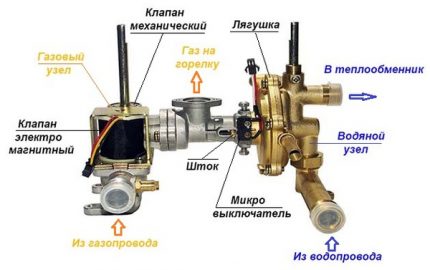
Gas ignition method
In general, gas water heaters are based on three methods of gas ignition. As can be seen in the diagram, in all three cases, the response to the ignition of the main burner is the reaction of the water node (frog).
Here are three ways to ignite:
- using a piezoelectric element;
- from batteries;
- from rotation of a hydraulic turbine.
Ignition with piezoelectric element - This is a manual ignition, and suggests the presence of a button on the front panel. Pressing the button closes the piezoelectric element that ignites the igniter. He, in turn, sets fire to the main burner after the signal of the rod, which moves the water membrane with an active pressure of water.
The ignitor continues to burn with a small flame until it is turned off manually. This leads to increased gas consumption and increased scale formation in the pipes. One of the gas-fired instantaneous water heaters with manual ignition is Bosch Therm 4000 O W 10-2 P.
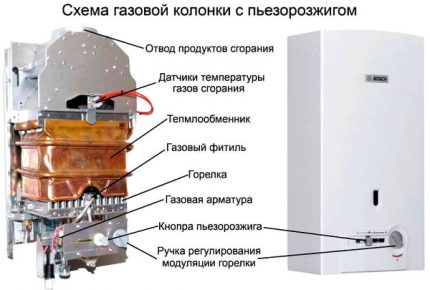
Geysers of some models work on battery powered. Whereinignition comes from an electric spark after a rod signal. Thus, instead of the igniter, there are electrodes that directly ignite the main gas burner.
But batteries need to be changed on average once every 10 months, and with constant use — every 2 months, so that there are no unforeseen circumstances. One of these battery powered speakers is Zanussi Gwh 10 Fonte Glass LaSpezia.
Sometimes ignition comes from rotation hydraulic turbines (with a stream of water). Ignition also comes from an electric spark, but the batteries do not need to be changed, because the turbine itself generates electricity during the flow of water.
But for the operation of the hydraulic turbine, a high pressure in the pipes is required, at least 0.3 bar. Not every house has this pressure. In Russia and other CIS countries, it is not advised to buy such columns because of the unstable pressure of water. As an example of such a model - a gas columnBosch Therm 6000 oWRD 15-2 G, which is noticeably more expensive than the two above models.
Column water assembly device
The arrangement of the water assembly is of particular interest. Its structure can be seen in the diagram below, the signature for the details - under the diagram. The remaining designated elements are used for fasteners.
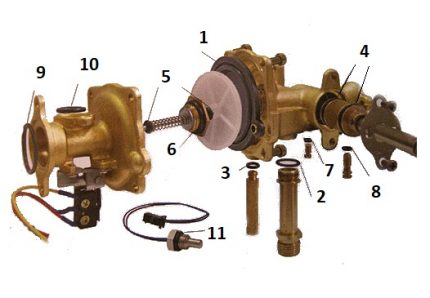
The main working details are stock and diaphragmunder the action of which it moves when a flow of water begins in the lower part. The stem opens the valve and passes gas into the burner, which is then ignited.
Another work item - PVC ballserving as a fuse. It blocks the gas flow during sudden pressure drops in the water pipes - water hammerwhich we will also talk about.
Type of combustion chamber
According to the arrangement of the combustion chambers, there are two types of gas water heaters: open and closed.
Speakers with open combustion chamber have open air access to the burner, and the combustion products go into the hood.
Such models are simpler thanturbocharged, which will be discussed below, their work is almost silent and in most cases they do not require electricity. However, due to the open connection between the combustion chamber and the room, air pollution in the room is possible due to poor operation of the hood.
Speakers with closed combustion chamber areturbocharged. The combustion chamber in them is sealed, in addition to the channels for pumping and air outlet. It is pumped there by a fan through coaxial pipes and goes outside through a chimney, together with combustion products.
Such columns are usually completely automated, they lack manual controls, and traction and temperature sensors are more sensitive. These speakers are “modern” and more secure.
In the illustrations above, a gas column with a closed combustion chamber was depicted. For comparison, in the following illustration, you can see the arrangement of two types of speakers side by side. You will find many similar elements in them, but the principle of removal of combustion products is noticeably different.
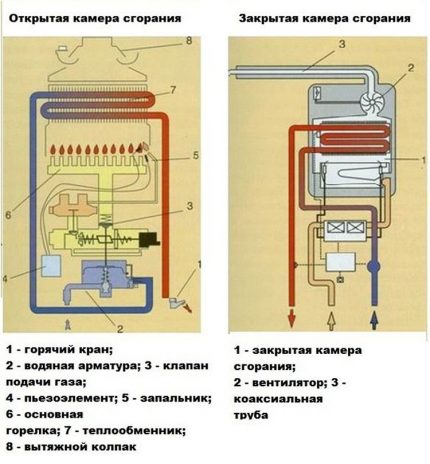
Key Features
Now let's talk about aspects of the practical use of the column. One of the main characteristics is performance. It is directly related to the power, which is indicated in kW and shows the volume of water heated at 25 ° C per minute.
Characteristics are usually indicated in the passport of the device. An ordinary column heats 10-20 liters of water at 25 ° C per minute, although this value can fluctuate significantly.
Another feature of modern speakers— power modulation. It shows how the column power can vary depending on the flow of water and is measured as a percentage of the initial power.
For modulation, the columns are equipped with special fittings with a membrane, which changes the gas supply to the burner depending on the flow. Modulation in the range of 40-100% of the device power is considered normal.
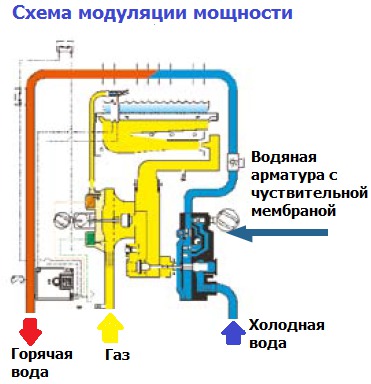
Safety sensors and their meaning
A geyser can be dangerous, because it is connected simultaneously with the water and gas pipelines, each of which individually can be a threat.
For problems with gas or water supply, safety sensors turn off the column, and special valves block the flow of water or gas.
Typically, geysers can withstand voltages up to 10-12 bar, which is 20-50 times higher than normal pipe pressure. Such sudden jumps are possible with the so-called water hammer.
But if the pressure is lower than 0.1-0.2 bar, then the column will not be able to work. You need to carefully study the instructions and specifications before buying to understand whether the column is optimized for low water pressure in the pipes of the CIS countries and whether it will work properly. And vice versa— whether it will withstand sudden changes in pressure, which, alas, is not uncommon in our conditions.
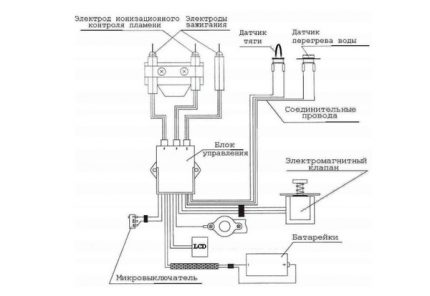
In general, a modern gas water heater contains many safety sensors. All of them, in case of breakdown, can be replaced.
More details about the purpose and location of the sensors are in the table below.
| Sensor Name | Location and purpose of the sensor |
| Chimney draft sensor | Located at the top of the device connecting the column to the chimney. Turns off the column when there is no draft in the chimney |
| Gas valve | It is located in the gas supply pipe. Turns off the column when the gas pressure drops |
| Ionization sensor | Located in the device’s camera. Turns off the device if the flame goes out when the gas is on. |
| Flame sensor | Located in the device’s camera. It shuts off the gas if the flame does not appear after ignition |
| Relief valve | Located on the water inlet. Turns off water at high pressure in the pipeline |
| Flow sensor | Turns off the column if the water stops flowing from the tap or if the water supply shuts off |
| temperature sensor | Located on the pipes of the heat exchanger. It blocks the operation of the burner with significant overheating of the water in order to avoid damage and burns (mainly triggered at + 85ºС and higher) |
| Low pressure sensor | It will not allow the column to turn on at reduced water pressure in the pipes. |
Main problems and ways to fix them
Speaking about the structure and principles of operation of a household gas column, as well as about the sensors built into it, it is worth briefly mentioning possible failures and malfunctions. Here we will not dwell on the complete repair or replacement of the column, but will quickly go through all the elements listed in the description of the burner and describe their malfunctions, as well as ways to deal with them with our own hands.
As already mentioned, the main element of the column— gas-burner. Often, the burner goes out due to the triggering of the safety sensors, which we have already talked about. Common problems that lead to this scenario — this heat exchanger fouling soot and scale.
Cause low pressure — scale formation in the pipes of the heat exchanger. In this case, you need to remove the heat exchanger, and rinse the pipes with special fluids to remove scale.
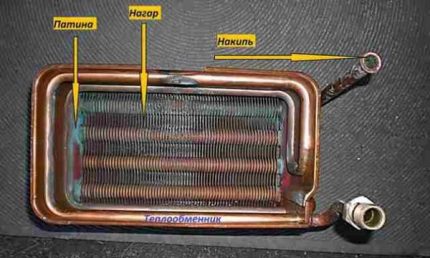
If the gas does not completely burn, or if the column has been in operation for a long time, it accumulates in the chamber soot from the outside, which significantly reduces the thermal conductivity and quality of water heating.
To learn more about the causes of low pressure and the intricacies of cleaning, please go to this link.
If the gas valve does not open due to the low pressure of the supplied water, it is necessary to remove filter, check how clogged it is and, if necessary, rinse. If the pressure of water or gas is insufficient, you will have to contact the appropriate public service.
If water flows directly from the column, it means that leakage in the pipes. It is necessary to disassemble them and replace the sealing elements. If necessary, the pipes themselves will have to be replaced.
Separately, it is worth recalling malfunctioning water membrane. If the column has been in operation for a long time, the membrane of the water unit wears out and its sensitivity drops significantly. It ceases to respond to low water pressure, and, accordingly, does not give a signal that you need to light the burner. In the best case, it should be changed every 5-6 years.
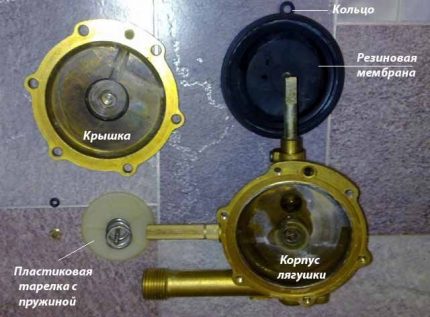
Sometimes the problem is also in stock, which moves the membrane, it can also be replaced if necessary, because there are special repair kits for this.
In order to better understand the device of your gas column model, you need to carefully study the instructions for use and the passport of the object. This will not only save you time and nerves, but also in itself will improve understanding of how this device works.
Conclusions and useful video on the topic
To consolidate the understanding of the structure of the gas column, you can look video review, where the location of all the elements of the column in a living example is explained in detail:
In this material, we studied the device of a household gas column, the principle of its action. Then we examined the work of the basic elements. And knowing the basic components and elements of gas equipment, sensors of its security system, you can diagnose a breakdown on your own. And if the cause of the malfunction is to contaminate individual structural elements, then perform own service gas column.
Do you want to supplement the above material with useful recommendations or ask questions that we have not raised here? Ask our experts and other website visitors for advice - the feedback form is located below.

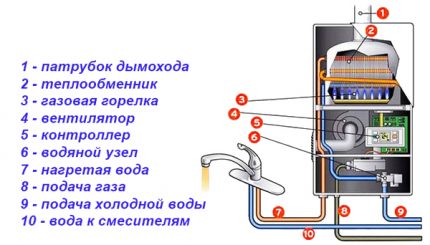
 Membrane for a geyser: purpose, principle of operation + replacement instructions
Membrane for a geyser: purpose, principle of operation + replacement instructions  Thermocouple for a gas column: design and principle of operation + self-inspection and replacement
Thermocouple for a gas column: design and principle of operation + self-inspection and replacement 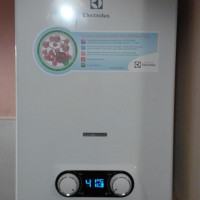 Electrolux Geyser Troubleshooting: Diagnosing Popular Breakdowns and Troubleshooting
Electrolux Geyser Troubleshooting: Diagnosing Popular Breakdowns and Troubleshooting 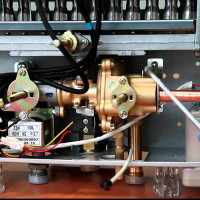 Repair of a Neva gas water heater: typical violations in operation and repair technology
Repair of a Neva gas water heater: typical violations in operation and repair technology  Do-it-yourself gas column installation in an apartment: requirements and technical standards for installation
Do-it-yourself gas column installation in an apartment: requirements and technical standards for installation 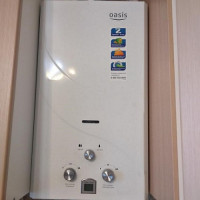 Oasis gas column repair: an overview of typical breakdowns and recommendations for their elimination
Oasis gas column repair: an overview of typical breakdowns and recommendations for their elimination  How much does it cost to connect gas to a private house: the price of organizing gas supply
How much does it cost to connect gas to a private house: the price of organizing gas supply  The best washing machines with dryer: model rating and customer tips
The best washing machines with dryer: model rating and customer tips  What is the color temperature of light and the nuances of choosing the temperature of the lamps to suit your needs
What is the color temperature of light and the nuances of choosing the temperature of the lamps to suit your needs  Replacement of a geyser in an apartment: replacement paperwork + basic norms and requirements
Replacement of a geyser in an apartment: replacement paperwork + basic norms and requirements